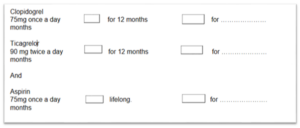Discharge Advice Following Coronary Angiography, Angioplasty or Stent insertion (PCI)
Please note, this page is printable by selecting the normal print options on your computer.
After your discharge from hospital, we will send a summary of your hospital stay to your GP or the consultant who referred you, explaining the outcome of the procedure and planned treatment.
Very important
If you have had a stent inserted in your heart artery/arteries during your procedure, you must continue to take a tablet called clopidogrel or ticagrelor. This is alongside aspirin, to prevent you from having a heart attack.
When clopidogrel or ticagrelor are taken with aspirin, this combination of tablets is often referred to as Dual Antiplatelet Therapy (DAPT). Both these tablets help reduce the risk of clots forming in and around your stents; if you develop clots in the stent, it can cause a heart attack which may be fatal.

Medication
Your medication will be explained to you before you go home, please ask if you have any questions. You should not stop any of your medications without speaking to your cardiologist or GP.
Side effects
It is normal to experience increased bruising whilst on clopidogrel or ticagrelor, but please speak to your GP if you are concerned or notice any unexpected bleeding, bruising or blood in your faeces/urine.
If you were taking anti-coagulant medication, such as warfarin, apixaban, rivaroxaban, edoxaban or dabigatran, your medication may be amended. You will be advised on what to take and when to restart it before you are discharged.
Diabetes Medication:
Metformin: Please restart 2 days after your procedure.
Insulin: Please restart your normal dose after the procedure.
What to Do When you go Home:
After you have had your procedure, we advise you to go straight home and rest for 12 to 24 hours. Do not drive yourself home and arrange for someone to collect you.
You must have a relative or friend at home with you during the night following your procedure and access to a telephone.
Care for the next 3 days following radial and femoral procedure:
- No heavy lifting or strenuous activity. For example, heavy housework, gardening, walking too far or sexual intercourse. Nothing repetitive ie; typing or computer games.
- You can have warm showers in the first 24 hours after your procedure. We advise you not to have a hot bath during this time as this may cause the artery to dilate again and cause bleeding.
- No alcohol for 24 hours.
- The plaster can be removed 24 hours after the procedure. If the puncture site is dry/healing, then you can leave it uncovered. If the puncture site is still wet/moist then you can put another plaster on it and recheck the next day.
It is important to keep checking the puncture site after your angiogram / angioplasty for the following:
- Bruising – it is quite normal to have some bruising. However, if a painful lump or swelling occurs contact the Nursing Staff in the Cardiac Catheter Suite or the Coronary Care Unit.
- Bleeding – Before you go home, your wound will be checked to ensure bleeding has stopped. When you leave, if you begin to bleed heavily from your wound, you notice the groin or wrist is swelling rapidly and is painful; apply firm pressure over the wound site and then dial 999 for an emergency ambulance stating you have an arterial bleed / bleeding from an artery.
- If your arm/leg is painful, feels cooler or looks a different colour from your other, please ring the Cardiac catheter Suite or Coronary care unit urgently or attend A&E Urgently.
- If your procedure was done through the groin and you have an Angioseal closure device, you may be able to feel a pea sized lump in your groin, this is due to the collagen seal used to close the puncture site; this is normal and will slowly dissolve over 60-90 to days. Keep the Angioseal Information Card with you for the next three months and ensure you inform your doctor if you have any further treatment in the groin area.
Contact your GP if any of the following symptoms occur:
- Fever
- Persistent tenderness or swelling in the groin or wrist
- Redness and/or warm to the touch
- Numbness or pain in the leg when walking (Femoral Approach)
- Numbness or pain in the wrist. (Radial approach)
- Any drainage from the puncture site (Radial or Femoral) – Rash
Driving following an elective/planned procedure:
There are DVLA driving restrictions which apply after some procedures:
- After an angiogram using the radial artery (wrist route)-you cannot drive for 3 days.
- After an angioplasty or stent (PCI) using the radial artery (wrist route)-you cannot drive for 7 days.
- After an angiogram using the femoral artery (groin route)- please do not drive for 24-48 hours.
- After an angioplasty or stent (PCI) using the femoral artery (groin route)-please do not drive for 7 days.
Lifestyle changes and future prevention.
If you have been told you have some disease in your arteries, then there are many things you can do to improve the situation.
Coronary artery disease is one of the most common causes of death in the UK. By making important lifestyle changes you will help to reduce your risk of cardiac problems in the future.
Risk factors for heart disease are:
- Smoking
- Family history
- Eating an unhealth diet
- High cholesterol levels
- If you have diabetes
- How much exercise you take
- High blood pressure
For more information about these risks, please ask for a booklet on lifestyle changes and secondary prevention.
Useful contacts:
Cardiac Angiography Unit 01908 996539 (Monday to Friday)
Cardiology Department 01908 997197 (Monday to Friday)
Ward 17/ Cardiology Ward 01908 996419 (24 hours)
Ward 17 may contact Oxford University Hospitals for advice and support, as your procedure may have been performed by an Oxford University Hospital Doctor.
British Heart Foundation Information Books are available from your Nurse.
Website: www.bhf.org.uk Helpline: 0808 802 1234 – open weekdays 9:00 – 17:00.
